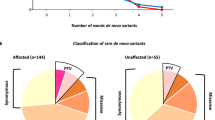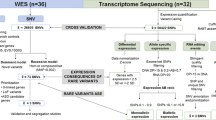Abstract
Autism is heterogeneous multifactorial neurodevelopmental and neuropsychiatric disorder with repetitive and limited behaviors as well as communication deficits. Prevalence of autism in males is predominant than females, but their genetic association is unclear. The study was performed to investigate Y-chromosome haplotypes, significant risk variants and susceptibility genes associated with autistic Saudi young males with autism. Exome genotyping microarray analysis was performed in Saudi young boys with autism (cases, n = 47) and without autism and other genetic or neurodevelopmental disorders (control, n = 43) to identify the functional exonic risk variations among 243,345 exonic variations. The most significant single nucleotide polymorphisms (SNPs) of protein coding associated with autism in Saudi young boys were studied for functional enrichment. Y-chromosome haplotyping analysis of 6 SNPs such as rs1865680, rs2032624, rs2032658, rs2032631, rs9786153 and rs13447352 uncovered the most significant protective (ACGACA p = 2.94 × 10−9) among the controls and the high risk Y-haplotype (GAAGTC p = 6.85 × 10−6) among autistic boys. Exome association study revealed 6 susceptible genes, MCC, AUTS2, VSX1, SETBP1, CNTN3, and PCDH11Y that were known for autistic disorder. The significant predisposed genes with functional variants of Y-chromomere are strongly connected with spermatogenic failure (p = 8.02 × 10−8), azoospermia (p = 6.32 × 10−7), partial chromosome Y deletion (p = 7.66 × 10−6), HDMs demethylate histones pathway (p = 3.55 × 10−4) and immune system diseases (p = 4.11 × 10−3). Y-haplotypes and highly significant pathogenic exonic variants in MCC, AUTS2, VSX1, SETBP1, CNTN3 and PCDH11Y genes are more influential genetic factors for developing autism in boys of Arab origin.



Similar content being viewed by others
References
Zoghbi HY, Bear MF (2012) Synaptic dysfunction in neurodevelopmental disorders associated with autism and intellectual disabilities. Cold Spring Harb Perspect Biol 4(3):a009886
Rylaarsdam LE, Guemez Gamboa A (2019) Genetic causes and modifiers in autism spectrum disorder. Front Cell Neurosci 13: 385
Almandil NB, Alkuroud DN, AbdulAzeez S, AlSulaiman A, Elaissari A, Borgio JF (2019) Environmental and genetic factors in autism spectrum disorders: special emphasis on data from Arabian studies. Int J Environ Res Public Health 16:658
Al-Mubarak B, Abouelhoda M, Omar A, AlDhalaan H, Aldosari M et al (2017) Whole exome sequencing reveals inherited and de novo variants in autism spectrum disorder: a trio study from Saudi families. Sci Rep 7:1–4
Alnemary FM, Aldhalaan HM, Simon-Cereijido G, Alnemary FM (2017) Services for children with autism in the Kingdom of Saudi Arabia. Autism 21:592–602
Al-Zahrani A (2013) Prevalence and clinical characteristics of autism spectrum disorders in school-age children in Taif-KSA. Int J Med Sci Public Health 2:578–582
Dayem Ullah AZ, Lemoine NR, Chelala C (2012) SNPnexus: a web server for functional annotation of novel and publicly known genetic variants (2012 update). Nucl Acids Res 40(W1):W65–W70
Purcell S, Neale B, Todd-Brown K, Thomas L, Ferreira MA, Bender D, Maller J, Sklar P, De Bakker PI, Daly MJ, Sham PC (2007) PLINK: a tool set for whole-genome association and population-based linkage analyses. Am J Hum Genet 8:559–575
Barrett JC, Fry B, Maller JD, Daly MJ (2005) Haploview: analysis and visualization of LD and haplotype maps. Bioinformatics 21:263–265
Sherman BT, Lempicki RA (2009) Systematic and integrative analysis of large gene lists using DAVID bioinformatics resources. Nat Protoc 4:44
Szklarczyk D, Morris JH, Cook H, Kuhn M, Wyder S et al (2016) The STRING database in 2017: quality-controlled protein–protein association networks, made broadly accessible. Nucl Acids Res 18:gkw937
Kuleshov MV, Jones MR, Rouillard AD, Fernandez NF, Duan Q, Wang Z, Koplev S, Jenkins SL, Jagodnik KM, Lachmann A, McDermott MG (2016) Enrichr: a comprehensive gene set enrichment analysis web server 2016 update. Nucl Acids Res 44(W1):W90–W97
Chen J, Bardes EE, Aronow BJ, Jegga AG (2009) ToppGene Suite for gene list enrichment analysis and candidate gene prioritization. Nucl Acids Res 37:W305–W311
Quintana-Murci L, Fellous M (2001) The human Y chromosome: the biological role of a “functional wasteland”. Biomed Res Int 1:18–24
Turner ME, Ely D, Prokop J, Milsted A (2011) Sry, more than testis determination? Am J Physiol Regul Integr Comp Physiol 301:R561–R571
Jobling MA, Tyler-Smith C (2000) New uses for new haplotypes: the human Y chromosome, disease and selection. Trends Genet 16:356–362
Serajee FJ, Mahbubul Huq AHM (2009) Association of Y chromosome haplotypes with autism. J Child Neurol 24:1258–1261
Jamain S, Quach H, Quintana-Murci L, Betancur C, Philippe A, Gillberg C et al (2002) Y chromosome haplogroups in autistic subjects. Mol Psychiatry 7:217–219
Weiner JA, Jontes J (2013) Protocadherins, not prototypical: a complex tale of their interactions, expression, and functions. Front Mol Neurosci 6:4
Priddle TH, Crow TJ (2013) The protocadherin 11X/Y (PCDH11X/Y) gene pair as determinant of cerebral asymmetry in modern Homo sapiens. Ann N Y Acad Sci 1288:36
Speevak MD, Farrell SA (2011) Non-syndromic language delay in a child with disruption in the Protocadherin11X/Y gene pair. Am J Med Genet B Neuropsychiatr Genet 156:484–489
Blanco-Arias P, Sargent CA, Affara NA (2004) Protocadherin X (PCDHX) and Y (PCDHY) genes; multiple mRNA isoforms encoding variant signal peptides and cytoplasmic domains. Mammalian Genome 15:41–52
Kalscheuer VM, FitzPatrick D, Tommerup N, Bugge M, Niebuhr E, Neumann LM, Tzschach A, Shoichet SA, Menzel C, Erdogan F, Arkesteijn G (2007) Mutations in autism susceptibility candidate 2 (AUTS2) in patients with mental retardation. Hum Genet 121:501–509
Barnett CP, van Bon BWM (2015) Monogenic and chromosomal causes of isolated speech and language impairment. J Med Genet 52:719–729
Coe BP, Witherspoon K, Rosenfeld JA, Van Bon BW, Vulto-van Silfhout AT, Bosco P, Friend KL, Baker C, Buono S, Vissers LE, Schuurs-Hoeijmakers JH (2014) Refining analyses of copy number variation identifies specific genes associated with developmental delay. Nat Genet 46:1063
Monies D, Abouelhoda M, AlSayed M, Alhassnan Z, Alotaibi M, Kayyali H, Al-Owain M, Shah A, Rahbeeni Z, Al-Muhaizea MA, Alzaidan HI (2017) The landscape of genetic diseases in Saudi Arabia based on the first 1000 diagnostic panels and exomes. Hum Genet 136:921–939
Ye H, Liu J, Wu JY (2010) Cell adhesion molecules and their involvement in autism spectrum disorder. Neurosignals 18:62–71
AbdulAzeez S, Al Qahtani NH, Almandil NB, Al-Amodi AM, Aldakeel SA, Ghanem NZ et al (2019) Genetic disorder prenatal diagnosis and pregnancy termination practices among high consanguinity population, Saudi Arabia. Sci Rep 9:17248
Wolin SL, Belair C, Boccitto M, Chen X, Sim S, Taylor DW et al (2013) Non-coding Y RNAs as tethers and gates: insights from bacteria. RNA Biol 10:1602–1608
Scheckel C, Drapeau E, Frias MA, Park CY, Fak J, Zucker-Scharff I et al (2016) Regulatory consequences of neuronal ELAV-like protein binding to coding and non-coding RNAs in human brain. eLife 5:e10421
Acknowledgements
The authors thank The Dean, Institute for Research and Medical Consultations (IRMC), Imam Abdulrahman Bin Faisal University, Dammam, Saudi Arabia for her continuous support and encouragement. We author appreciate the technical assistance from Mr. Ranilo M. Tumbaga, Mr. Horace T. Pacifico, and Ms. Jee E. Aquino.
Funding
This study was funded by by the Deanship of Scientific Research, Imam Abdulrahman Bin Faisal University (Grant No: 2016-057-IRMC, 2017-202-IRMC and 2018-094-IRMC).
Author information
Authors and Affiliations
Corresponding author
Ethics declarations
Conflict of interest
The authors declare that they do not have any commercial or associative interest that represents a conflict of interest in connection with the work submitted.
Ethical approval
All procedures performed in studies involving human participants were in accordance with the ethical standards of the institutional and/or national research committee and with the 1964 Helsinki declaration and its later amendments or comparable ethical standards.
Informed consent
Informed consent was obtained from the parents/legally authorized representatives of the children involved in the study.
Additional information
Publisher's Note
Springer Nature remains neutral with regard to jurisdictional claims in published maps and institutional affiliations.
Electronic supplementary material
Below is the link to the electronic supplementary material.
11033_2020_5832_MOESM2_ESM.pdf
Electronic supplementary material 1 Analysis of Twelfths SNPs falls in the coding region of Ychromosome haplotypes (PDF 52 kb)
Rights and permissions
About this article
Cite this article
Alsubaie, L.M., Alsuwat, H.S., Almandil, N.B. et al. Risk Y-haplotypes and pathogenic variants of Arab-ancestry boys with autism by an exome-wide association study. Mol Biol Rep 47, 7623–7632 (2020). https://doi.org/10.1007/s11033-020-05832-6
Received:
Accepted:
Published:
Issue Date:
DOI: https://doi.org/10.1007/s11033-020-05832-6




